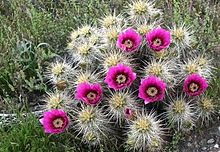Echinocereus engelmannii
| Echinocereus engelmannii | |
|---|---|
 |
|
| Scientific classification | |
| Kingdom: | Plantae |
| (unranked): | Angiosperms |
| (unranked): | Eudicots |
| (unranked): | Core eudicots |
| Order: | Caryophyllales |
| Family: | Cactaceae |
| Subfamily: | Cactoideae |
| Tribe: | Pachycereeae |
| Genus: | Echinocereus |
| Species: | E. engelmannii |
| Binomial name | |
|
Echinocereus engelmannii (Parry ex Engelm.) Lem. |
|
The strawberry hedgehog cactus or Engelmann's hedgehog cactus (Echinocereus engelmannii) is commonly found in desert areas of the southwestern United States and the adjacent areas of Mexico, including the states of California, Nevada, Utah, Arizona, Baja California and Sonora. It usually grows in clusters, sometimes up to 20 and more stems. Its bright magenta flowers bloom in April in its southern extremes to late May at northern locations. The flowers are borne at the upper half to one third of the stem. They are funnelform in shape, up to 3.5 inches long with dark-green stigmas. The fruit is very spiny. At first it is green, becoming pink and drying when ripe. The ripe fruit has spines which are easily detached. The seeds are black, and around a tenth of an inch in size.
The stems are initially cylindrical and erect in young plants, but later with the stem base lying on the ground. The stems are usually 1.5 to 3.5 inches in diameter and up to 25 inches high, and obscured by heavy spines. The plants have around 10 ribs, which are somewhat flattened and tuberculate.
Spines variable in color and size. Radial spines are shorter and needlelike, up to 0.8 inch long, white and arranged in a neat rosette. Central spines number 2 to 7 and are stout, usually twisted or angular, up to 3 inches long and variable in color: bright yellow, dark brown, grey, and white.
Echinocereus engelmannii is commonly used as a landscape plant in its native areas. In pot culture it requires well aerated gritty substrate, and a hot and sunny location in the summer. In the winter the plant easily tolerates light frost and wet (if well-drained) soil. In cultivation it usually does not bloom until it develops 2-3 branches.
...
Wikipedia

